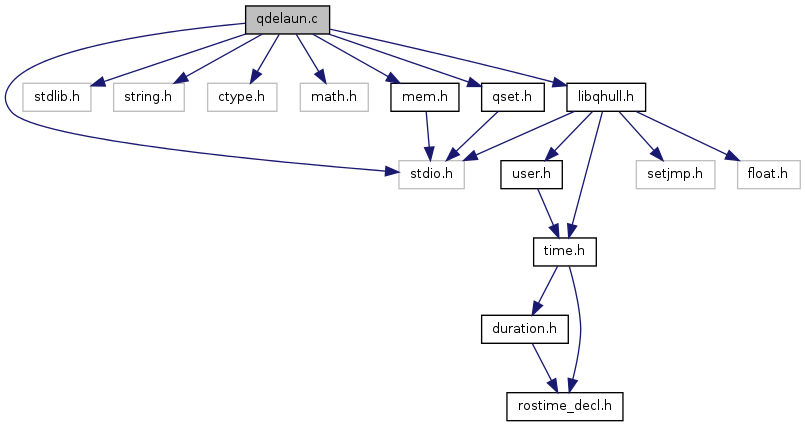#include <stdio.h>
#include <stdlib.h>
#include <string.h>
#include <ctype.h>
#include <math.h>
#include "libqhull.h"
#include "mem.h"
#include "qset.h"
Go to the source code of this file.
Function Documentation
| int main |
( |
int |
argc, |
|
|
char * |
argv[] |
|
) |
| |
Variable Documentation
| char hidden_options[] = " d n v H U Qb QB Qc Qf Qg Qi Qm Qr QR Qv Qx TR E V FC Fi Fo Ft Fp FV Q0 Q1 Q2 Q3 Q4 Q5 Q6 Q7 Q8 Q9 " |
Initial value:"\n\
qdelaunay- compute the Delaunay triangulation. Qhull %s\n\
input (stdin): dimension, number of points, point coordinates\n\
comments start with a non-numeric character\n\
\n\
options (qdelaun.htm):\n\
Qu - furthest-site Delaunay triangulation\n\
Qt - triangulated output\n\
QJ - joggled input instead of merged facets\n\
Tv - verify result: structure, convexity, and in-circle test\n\
. - concise list of all options\n\
- - one-line description of all options\n\
\n\
output options (subset):\n\
s - summary of results (default)\n\
i - vertices incident to each Delaunay region\n\
Fx - extreme points (vertices of the convex hull)\n\
o - OFF format (shows the points lifted to a paraboloid)\n\
G - Geomview output (2-d and 3-d points lifted to a paraboloid)\n\
m - Mathematica output (2-d inputs lifted to a paraboloid)\n\
QVn - print Delaunay regions that include point n, -n if not\n\
TO file- output results to file, may be enclosed in single quotes\n\
\n\
examples:\n\
rbox c P0 D2 | qdelaunay s o rbox c P0 D2 | qdelaunay i\n\
rbox c P0 D2 | qdelaunay Fv rbox c P0 D2 | qdelaunay s Qu Fv\n\
rbox c G1 d D2 | qdelaunay s i rbox c G1 d D2 | qdelaunay Qt\n\
rbox M3,4 z 100 D2 | qdelaunay s rbox M3,4 z 100 D2 | qdelaunay s Qt\n\
\n\
"
Definition at line 178 of file qdelaun.c.
Initial value:"\n\
Qhull %s.\n\
Except for 'F.' and 'PG', upper-case options take an argument.\n\
\n\
incidences mathematica OFF_format points_lifted summary\n\
facet_dump\n\
\n\
Farea FArea_total Fcoincident Fd_cdd_in FD_cdd_out\n\
FF_dump_xridge FIDs Fmerges Fneighbors FNeigh_vertex\n\
FOptions FPoint_near FQdelaun Fsummary FSize\n\
Fvertices Fxtremes FMaple\n\
\n\
Gvertices Gpoints Gall_points Gno_planes Ginner\n\
Gcentrums Ghyperplanes Gridges Gouter GDrop_dim\n\
Gtransparent\n\
\n\
PArea_keep Pdrop d0:0D0 Pgood PFacet_area_keep\n\
PGood_neighbors PMerge_keep Poutput_forced Pprecision_not\n\
\n\
QGood_point QJoggle Qsearch_1st Qtriangulate QupperDelaunay\n\
QVertex_good Qzinfinite\n\
\n\
T4_trace Tcheck_often Tstatistics Tverify Tz_stdout\n\
TFacet_log TInput_file TPoint_trace TMerge_trace TOutput_file\n\
TWide_trace TVertex_stop TCone_stop\n\
\n\
Angle_max Centrum_size Random_dist Wide_outside\n\
"
Definition at line 216 of file qdelaun.c.
Initial value:"\n\
qdelaunay- compute the Delaunay triangulation\n\
http://www.qhull.org %s\n\
\n\
input (stdin):\n\
first lines: dimension and number of points (or vice-versa).\n\
other lines: point coordinates, best if one point per line\n\
comments: start with a non-numeric character\n\
\n\
options:\n\
Qu - compute furthest-site Delaunay triangulation\n\
Qt - triangulated output\n\
QJ - joggled input instead of merged facets\n\
\n\
Qhull control options:\n\
QJn - randomly joggle input in range [-n,n]\n\
%s%s%s%s"
Definition at line 59 of file qdelaun.c.
Initial value:"\
Qs - search all points for the initial simplex\n\
Qz - add point-at-infinity to Delaunay triangulation\n\
QGn - print Delaunay region if visible from point n, -n if not\n\
QVn - print Delaunay regions that include point n, -n if not\n\
\n\
"
Definition at line 76 of file qdelaun.c.
Initial value:"\
More formats:\n\
Fa - area for each Delaunay region\n\
FA - compute total area for option 's'\n\
Fc - count plus coincident points for each Delaunay region\n\
Fd - use cdd format for input (homogeneous with offset first)\n\
FD - use cdd format for numeric output (offset first)\n\
FF - facet dump without ridges\n\
FI - ID of each Delaunay region\n\
Fm - merge count for each Delaunay region (511 max)\n\
FM - Maple output (2-d only, lifted to a paraboloid)\n\
Fn - count plus neighboring region for each Delaunay region\n\
FN - count plus neighboring region for each point\n\
FO - options and precision constants\n\
FP - nearest point and distance for each coincident point\n\
FQ - command used for qdelaunay\n\
Fs - summary: #int (8), dimension, #points, tot vertices, tot facets,\n\
for output: #vertices, #Delaunay regions,\n\
#coincident points, #non-simplicial regions\n\
#real (2), max outer plane, min vertex\n\
FS - sizes: #int (0)\n\
#real (2), tot area, 0\n\
Fv - count plus vertices for each Delaunay region\n\
Fx - extreme points of Delaunay triangulation (on convex hull)\n\
\n\
"
Definition at line 116 of file qdelaun.c.
Initial value:"\
Geomview options (2-d and 3-d)\n\
Ga - all points as dots\n\
Gp - coplanar points and vertices as radii\n\
Gv - vertices as spheres\n\
Gi - inner planes only\n\
Gn - no planes\n\
Go - outer planes only\n\
Gc - centrums\n\
Gh - hyperplane intersections\n\
Gr - ridges\n\
GDn - drop dimension n in 3-d and 4-d output\n\
Gt - transparent outer ridges to view 3-d Delaunay\n\
\n\
Print options:\n\
PAn - keep n largest Delaunay regions by area\n\
Pdk:n - drop facet if normal[k] <= n (default 0.0)\n\
PDk:n - drop facet if normal[k] >= n\n\
Pg - print good Delaunay regions (needs 'QGn' or 'QVn')\n\
PFn - keep Delaunay regions whose area is at least n\n\
PG - print neighbors of good regions (needs 'QGn' or 'QVn')\n\
PMn - keep n Delaunay regions with most merges\n\
Po - force output. If error, output neighborhood of facet\n\
Pp - do not report precision problems\n\
\n\
. - list of all options\n\
- - one line descriptions of all options\n\
"
Definition at line 142 of file qdelaun.c.
